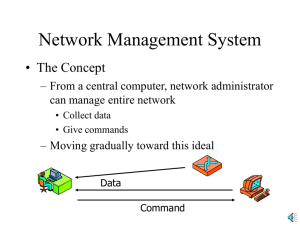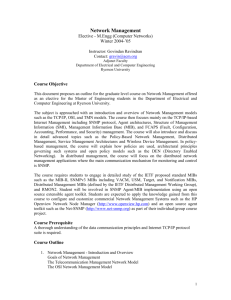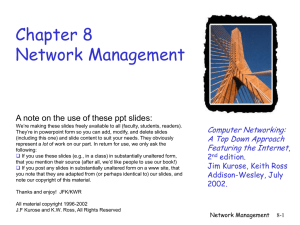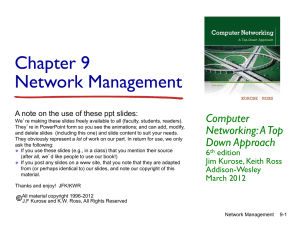SNMP - TATI
advertisement
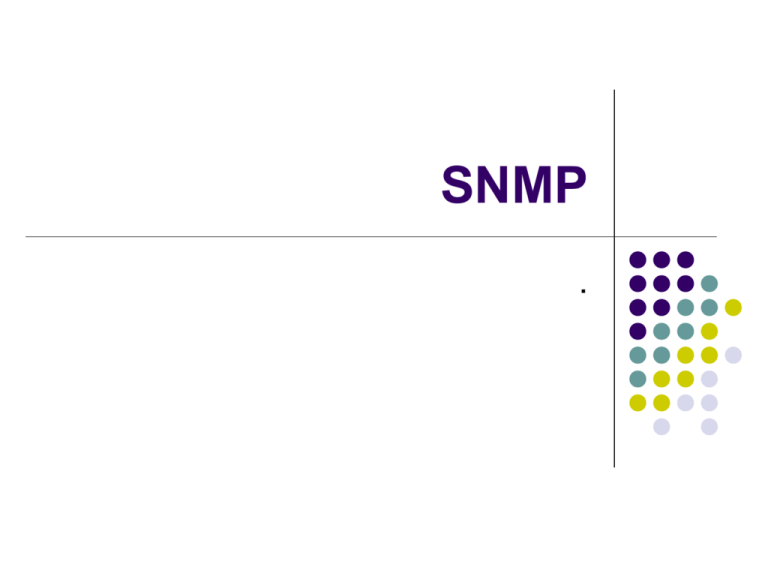
SNMP
.
Overview
Introduction
Management Information Base
(MIB)
Simple Network Management Protocol (SNMP)
SNMP Commands
Tools
- ‘SNMPwalk’ (CLI)
- ‘MIB Browser’ (GUI)
Introduction
(1) SNMP
- Application-layer protocol for managing TCP/IP based
networks.
- Runs over UDP, which runs over IP
(2) NMS (Network Management Station)
- Device that pools SNMP agent for info.
(3) SNMP Agent
- Device (e.g. Router) running software that understands SNMP
language
(4) MIB
- Database of info conforming to SMI.
(5) SMI Structure of Management Information
- Standard that defines how to create a MIB.
MIB – Management Information Base
-
MIB Breakdown…
OBJECT-TYPE
-
-
SYNTAX
-
-
READ-ONLY, READ-WRITE.
STATUS
-
-
Defines what kind of info is stored in
the MIB object.
ACCESS
-
-
String that describes the MIB object.
Object IDentifier (OID).
State of object in regards the SNMP
community.
DESCRIPTION
-
Reason why the MIB object exists.
Standard MIB Object:
sysUpTime OBJECT-TYPE
SYNTAX Time-Ticks
ACCESS read-only
STATUS mandatory
DESCRIPTION
“Time since the
network management
portion of the system
was last re-initialised.
::= {system 3}
MIB – Management Information Base
iso(1)
Object IDentifier (OID)
1
org(3)
3
- Example .1.3.6.1.2.1.1
dod(6)
6
- iso(1) org(3) dod(6) internet(1)
mgmt(2)
mib-2(1)
system(1)
internet(1)
1
private(4)
directory(1)
4
1
mgmt(2)
experimental(3)
2
3
Note:
- .1.3.6.1 ~100% present.
- mgmt and private most common.
- MIB-2 successor to original MIB.
- STATUS ‘mandatory’, All or nothing in group
mib-2(1)
1
tcp(6)
system(1)
6
1
interfaces(2)
2
ip(4)
4
MIB – Management Information Base
system(1) group
mib-2(1)
1
-
Contains objects that describe some basic
information on an entity.
An entity can be the agent itself or the
network object that the agent is on.
system(1)
1
interfaces(2)
2
system(1) group objects
- sysDescr(1)
- sysObjectID(2)
- sysUpTime(3)
- sysContact(4)
Description of the entity.
Vendor defined OID string.
Time since net-mgt was last re-initialised.
Name of person responsible for the entity.
MIB – Management Information Base
MIB - tree view
MIB - syntax view
mib-2(1)
1
system(1)
1
sysContact(3)
4
sysUpTime(3)
sysDesc(1)
3
1
sysObjectID(2)
2
sysUpTime OBJECT-TYPE
SYNTAX INTEGER
ACCESS read-only
STATUS mandatory
DESCRIPTION
“The time (in
hundredths of a
second) since the
network management
portion of the system
was last re-initialized.”
::= {system 3}
MIB – Management Information Base
-
SNMP Instances
Each MIB object can have an instance.
-
A MIB for a router’s (entity) interface information…
iso(1) org(3) dod(6) internet(1) mgmt(2) mib-2(1) interfaces(2) ifTable(2) ifEntry(1) ifType(3)
-
Require one ifType value per interface (e.g. 3)
One MIB object definition can represent multiple
instances through Tables, Entries, and Indexes.
Simple Network Management Protocol
Retrieval protocol for MIB.
Can retrieve by
-
CLI (snmpwalk),
GUI (MIB Browser), or
Larger applications (Sun Net Manager) called Network
Management Software (NMS).
NMS collection of smaller applications to manage
network with illustrations, graphs, etc.
NMS run on Network Management Stations (also
NMS), which can run several different NMS software
applications.
SNMP Commands
SNMP has 5 different functions referred to as
Protocol Data Units (PDU’s), which are:
(1) GetRequest, aka Get
(2) GetNextRequest, aka GetNext
(3) GetResponse, aka Response
(4) SetRequest, aka Set
(5) Trap
SNMP Commands [Get]
GetRequest [Get]
-
-
Most common PDU.
Used to ask SNMP agent for value of a particular
MIB agent.
NMS sends out 1 Get PDU for each instance,
which is a unique OID string.
SNMP Commands [GetNext]
GetNextRequest [GetNext]
-
NMS application uses GetNext to ‘walk’ down a
table within a MIB.
Designed to ask for the OID and value of the MIB
instance that comes after the one asked for.
Once the agent responds the NMS application
can increment its count and generate a GetNext.
This can continue until the NMS application
detects that the OID has changed, i.e. it has
reached the end of the table.
SNMP Commands [GetResponse]
GetResponse [Response]
-
Simply a response to a Get, GetNext or Set.
SNMP agent responds to all requests or
commands via this PDU.
SNMP Commands [SetRequest]
SetRequest [Set]
-
Issued by an NMS application to change a MIB
instance to the variable within the Set PDU.
For example, you could issue a
-
-
-
GetRequest against a KDEG server asking for
sysLocation.0 and may get ‘ORI’ as the response.
Then, if the server was moved, you could issue a Set
against that KDEG server to change its location to
‘INS’.
You must have the correct permissions when
using the set PDU.
SNMP Commands [Trap]
Trap
-
-
Asynchronous notification.
SNMP agents can be programmed to send a trap
when a certain set of circumstances arise.
Circumstances can be view as thresholds, i.e. a
trap may be sent when the temperature of the
core breaches a predefined level.
SNMP Security
SNMP Community Strings (like passwords)
-
3 kinds:
-
-
-
READ-ONLY: You can send out a Get & GetNext to
the SNMP agent, and if the agent is using the same
read-only string it will process the request.
READ-WRITE: Get, GetNext, and Set. If a MIB object
has an ACCESS value of read-write, then a Set PDU
can change the value of that object with the correct
read-write community string.
TRAP: Allows administrators to cluster network
entities into communities. Fairly redundant.
SNMP Tools
Command Line Interface
e.g. ‘snmpwalk’
Graphical User Interface
e.g. iReasoning’s MIB Browser
http://209.59.152.192/download/mibpro/mibbrowser.zip
Or via www.ireasoning.com
SNMP – MIB Browser (1)
Initial set-up... java -Xmx384m -jar “XYZ\lib\browser.jar” (where XYZ = your specific path)
Breakdown…
- LHS is the
SNMP MIB
structure.
- Lower LHS
has details of
MIB structure.
- RHS will
present MIB
values.
SNMP – MIB Browser (2)
Discovery…
- Subnet: 134.XXX.XXX.*
- Read Community: public
Start
Note IP Address.
Stop
SNMP – MIB Browser (3)
Navigation…
- MIB Tree
System
sysUpTime
-Notice Lower LHS
- Notice OID
SNMP – MIB Browser (4)
SNMP PDU’s…
(1) Get
- Select ‘Go’
‘Get’
- RHS has values.
- OID – Value
SNMP – MIB Browser (5)
SNMP PDU’s…
(2) GetNext
-Selected OID is:
.1.3.6.1.2.1.1.5
-Returned value:
(.1.3.6.1.2.1.1.6)
or
“DSG, O’Reilly Institute,
F.35”
SNMP – MIB Browser (6)
SNMP…
(3) Get SubTree
-Position of MIB:
.1.3.6.1.2.1.1
(a.k.a. system)
-RHS values:
Returns all values
below system.
SNMP – MIB Browser (7)
SNMP…
(4) Walk
-MIB Location:
.1.3.6.1.2.1
(a.k.a. mib-2)
- Returns *ALL*
values under mib2
SNMP – MIB Browser (8)
Tables…
- MIB Location:
.1.3.6.1.2.1.2.2
(or interfaces)
- Select ifTable,
Go, then Table
View.
- Refresh/Poll
SNMP – MIB Browser (9)
SNMP…
- Graph
-
Select a
value from
the RHS, say
sysUpTime
-
Highlight and
select ‘Go’,
then ‘Graph’.
-
Interval = 1s
set.

